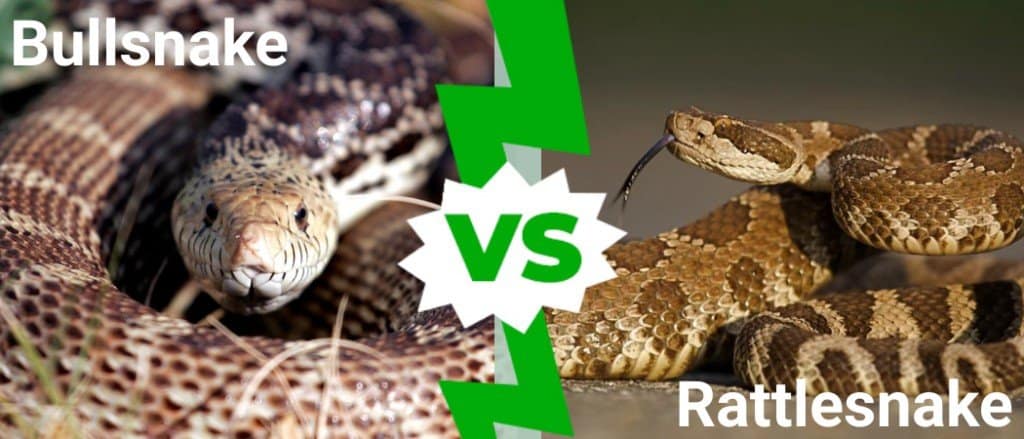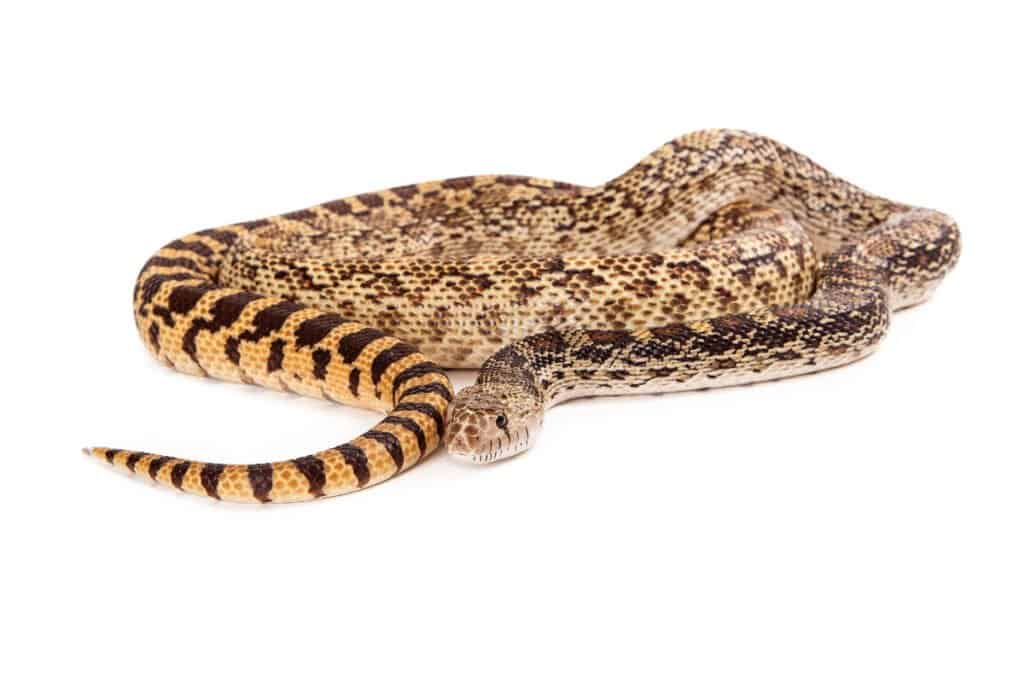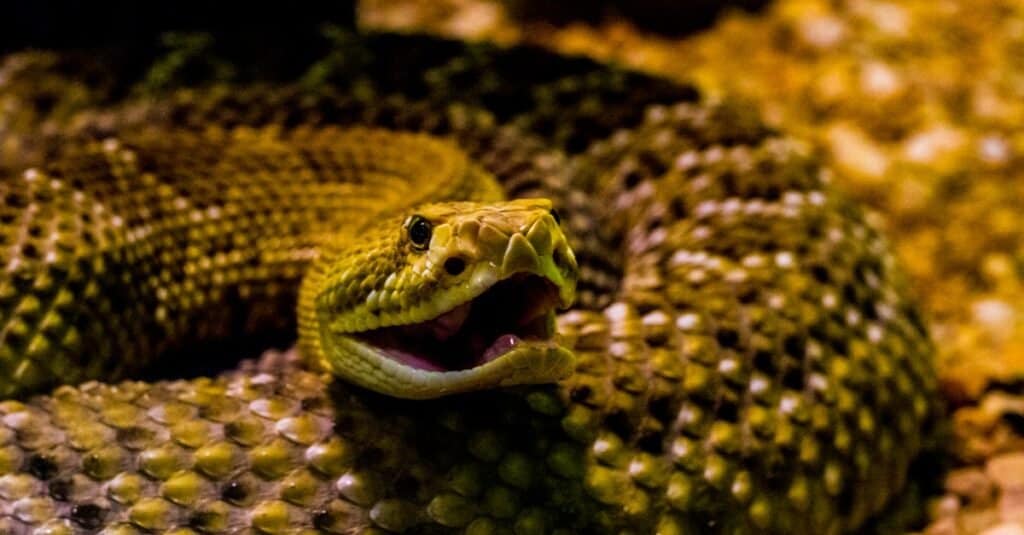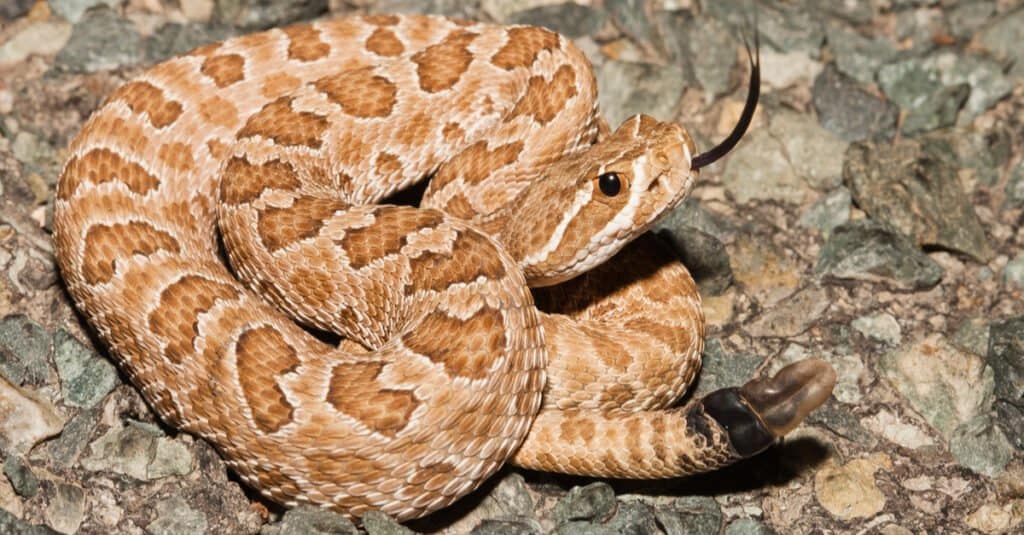There is often debate regarding the similarities between bullsnakes and rattlesnakes. Both of these snakes belong to the Serpentes family, of course, but their species are different. When it comes down to comparing the bull snake vs rattlesnake, what are their key differences?
Rattlesnakes belong to the Crotalinae family, also known as the pit viper family. Bullsnakes belong to the Colubridae, which includes kingsnakes, corn snakes, and garter snakes. But this isn’t where their differences end. Let’s talk more about the ways in which these two snakes differ from each other now.
Comparing Bullsnakes vs Rattlesnakes

| Bullsnake | Rattlesnake | |
|---|---|---|
| Location | North America | North America, Mexico, Argentina |
| Color | Yellow, brown, orange, splotches | Shades of brown, diamond/striped pattern |
| Lifespan | 10-25 years | 10-20 years |
| Size | 4-8 feet long | 3-5 feet long |
| Special Features | An excellent mimic | Has a rattle and pits for sensing |
| Method of Killing | Constriction | Venom |
| Venomous? | No | Yes |
The 4 Key Differences Between Bullsnakes vs Rattlesnakes
There are key differences that separate bull snakes vs rattlesnakes. Bullsnakes are non-venomous, and tend to kill using constriction. Rattlesnakes utilize venom and warn potential predators away using a rattle, something that the bullsnake does not possess. The markings on bullsnakes are also different from the markings on rattlesnakes, though it can be difficult to tell them apart at first.
Let’s dive a little deeper into what makes the bullsnake and the rattlesnake so different.

The markings on bullsnakes are different from the markings on rattlesnakes.
©Susan Schmitz/Shutterstock.com
Bull Snakes vs Rattlesnakes: How They Kill
Bullsnakes and rattlesnakes both eat similar things, given that they are carnivorous snakes. However, the way that they kill their prey is very different. Bullsnakes constrict their meals before swallowing them whole, while rattlesnakes choose to use their powerful venom to achieve this same result.
Rattlesnakes also have an advantage over bullsnakes in the way that they hunt. Rattlesnakes have a facial pit that allows them to sense prey in the night, a pit viper feature that bullsnakes do not share.

Rattlesnakes have a facial pit that allows them to sense prey in the night.
©iStock.com/Paulo Almeida
Bullsnakes vs Rattlesnakes: Venomous or Not?
Another key difference between bullsnakes and rattlesnakes is their venom. Bullsnakes are non venomous, meaning they can bite you but will not inject venom. Rattlesnakes are another story altogether: they have a fairly potent venom that can even kill grown adults if left untreated.
However, this isn’t to say that rattlesnakes are inherently more aggressive than bullsnakes– far from it. Bullsnakes are regarded as a much more aggressive species than rattlesnakes are, capable of pursuing predators far more than rattlesnakes do. While rattlesnakes are more dangerous overall, they tend to be a much shyer snake than bullsnakes are.
Bullsnakes vs Rattlesnakes: Head Shape and Body Markings
Bullsnake vs rattlesnake markings is another big difference between the two species. While it can be difficult to tell the difference between the two upon first glance, there are ways you can tell the snakes apart based on their markings alone.
Rattlesnakes have a much more unique and distinct pattern along their back when compared to bullsnakes. They can have a striped or diamond pattern, earning some species of rattlesnakes the name “diamondback”. They are also found in more colors than bullsnakes are, ranging from dark brown all the way to pink!
Bullsnakes can be patterned as well, but it is often more muddled or splotchy when compared to a rattlesnake. Most bullsnakes are a light yellow or brown color, with orange or red markings, all faded.

Compared to bullsnakes, rattlesnakes have a much more unique and distinct pattern along their back.
©Nathan A Shepard/Shutterstock.com
Bullsnakes vs Rattlesnakes: Presence of a Rattle
Another telltale difference between bullsnakes vs rattlesnakes is the presence of a rattle. Rattlesnakes are well known for their unique rattling tails, and they use these tails as a warning for predators that try to get too close. Bullsnakes possess no rattle at the end of their tails, but they do something that may confuse you at first.
Bullsnakes are excellent mimics, capable of emitting a low growling or rattling sound from within. They coil up similarly to rattlesnakes as well, and this mimicry may be something that confuses people when trying to tell the difference between bullsnakes vs rattlesnakes.
How Do You Keep Snakes Away?

Bird feeders can attract many varieties of beautiful birds to your yard, but can also draw rodents and snakes who prey on them.
©Nancy Salmon/Shutterstock.com
While snakes in the wild serve a valuable purpose by keeping down rodent populations, some people are just unable to see the good in these slithering serpents. You especially would not want one slipping into your home unannounced! So what are some ways to keep snakes outside where they belong, and preferably, out of your yard as well?
Below are 10 simple steps you can take to help keep the snake population down in and around your home:
- Sealing Up Cracks–You’ll need to search the perimeter of your home for access points, warm or damp crawl spaces, or holes in your home’s foundation or near ground level. Storm drains are also attractive to snakes. Sealing these entry points appropriately is a start to keeping snakes out.
- Removing Potential Food Sources–You may not have realized that bird feeders are potential problems, as they not only attract birds but also rodents and insects, both of which attract snakes. Outdoor pet food can have the same effect. If possible, feed your pets indoors and keep any outdoor seed or other foods in sealed containers.
- Removing Standing Water–Standing water can attract frogs, lizards, small mammals, and snakes. Try to reduce standing water as much as possible, even if it means watering your lawn less.
- Trapping the Snake–If there are just a few pesky snakes troubling you, you can purchase professionally-made snake traps at your local hardware store and try to snag them. Rather than killing them, consider transporting the snakes about 6 miles away and freeing them in the wild.
- Building Strong Fences–There are special types of fences that can keep snakes out, usually made of vinyl or tight wire mesh. Consulting your local hardware store for advice can help with this strategy.
- Employing Proper Landscaping and Maintenance–Snakes are drawn to areas of overgrown vegetation, loose debris, wood piles, or other areas where they can hide. Keeping your yard maintained regularly can help cut down on places for snakes to hang out.
- Bringing in Domesticated Fowl–This may be an extreme solution, but domestic fowl like chickens are capable of managing snake populations, especially roosters, who protect hens and chicks from danger.
- Luring Birds of Prey–Growing tall trees with strong branches can be a way to attract birds of prey like owls, who like to prey on snakes. Another idea would be to build a nesting box to make them feel at home.
- Calling Wildlife Control–When all else fails, there’s always the option of calling a professional to come remove an unwanted snake from your property. Exterminators are also valuable, as they can help rid your house of rodents, which attract snakes.
- Removing Debris and Keeping Woodpiles Off the Ground–This one is similar to #6, but focuses on woodpiles, which should not be left sitting on the ground if you want to keep snakes away. Elevating them will help deter snakes, as well as remove empty containers and piles of debris where snakes may gather.
The photo featured at the top of this post is © iStock.com/92968526
Discover the "Monster" Snake 5X Bigger than an Anaconda
Every day A-Z Animals sends out some of the most incredible facts in the world from our free newsletter. Want to discover the 10 most beautiful snakes in the world, a "snake island" where you're never more than 3 feet from danger, or a "monster" snake 5X larger than an anaconda? Then sign up right now and you'll start receiving our daily newsletter absolutely free.
FAQs (Frequently Asked Questions)
Do bullsnakes keep rattlesnakes away?
Bullsnakes have been known to keep rattlesnakes away. Most rattlesnakes are non confrontational, so they tend to avoid an area with a bullsnake in it. They don’t want to encroach on a bullsnake’s territory, so, in a way, bullsnakes do help keep rattlesnakes away.
Are bullsnakes dangerous?
Bullsnakes can be dangerous. While their bite contains no venom and is relatively safe compared to the bite of a rattlesnake, bullsnakes are a highly aggressive species of snake. They have been known to pursue humans and animals if surprised, so it is always best to avoid a bullsnake should you see one.
Can bullsnakes rattle like rattlesnakes?
Bullsnakes can produce a type of rattle that sounds similar to rattlesnakes. However, they do not possess a rattle at the end of their tail like rattlesnakes do. They use their chests to produce this sound rather than an external rattle.
Thank you for reading! Have some feedback for us? Contact the AZ Animals editorial team.






